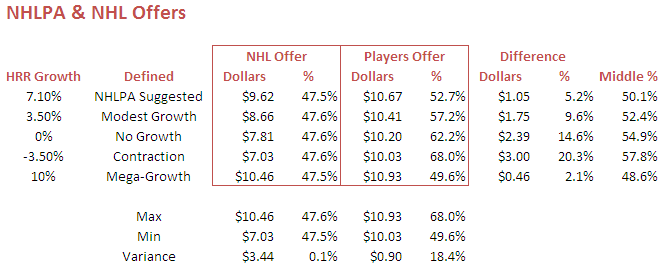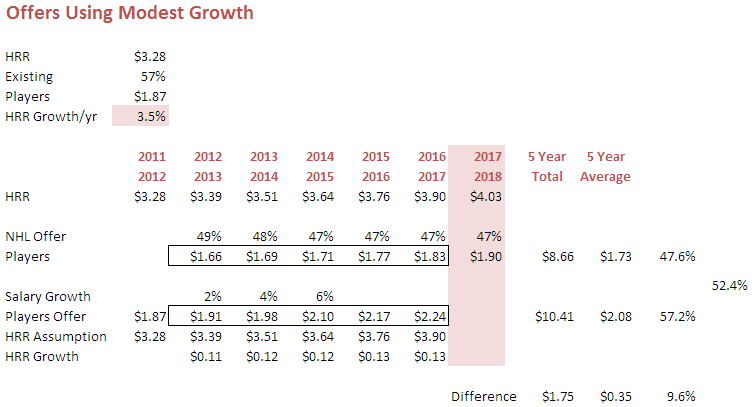In social issues, politics and even sports public opinion is tough to assess.
People can be polled one way, but react another when choices involve actions and not just a quick answer. The silent majority can quite often be poorly represented by the loud minority who take to the streets, start web based petitions or create youtube videos slagging their favorite targets. Don’t even get me started on the “no comment” group that for whatever reason agree to answer a poll but then have no opinion in filling in the answer; nobody can help them.
To date the NHL and the NHLPA have attempted, I’d argue largely in vain, to win the hearts of the hockey fan in a way to gain leverage in a dispute that today has become 11 days old. It’s not working.
Instead of galvanizing support both sides have found themselves thrown in with their sworn enemy with references to two spoiled brats fighting over a toy in the playground.
It’s become tiresome, predictable, and a little insulting in my opinion. Hockey fans deserve better than this, we’ve been through it too recently, and it shouldn’t be happening again. Hockey fans want hockey, not a daily jockeying of for approval through the use of quote manipulation and PR stunts.
But how to stop the madness?
Thicker Skin
First up both sides need to develop some thicker skin.
I’m sure the NHL owners don’t like the fact that their well paid players are suggesting that they are less than honest in pleading a need for system change despite getting their intended system 8 years ago. It’s likely a lot easier for an owner from Calgary to read Jason Spezza taking pot shots at the NHL negotiation stance then it is to hear Jarome Iginla suggesting owners are big billionaire bullies.
But suck it up.
And don’t react like Jimmy Devellano did when he uttered the ranch vs cattle soliloquy earlier this week. One has to get their heads around how things will be perceived before just opening once’s mouth and letting things fall out of it.
And the players? It was an analogy. A poorly timed analogy, but an analogy nonetheless. I don’t think Mr. Devellano thinks you have horns and hoofs.
To suggest that NHL owners think their players are sub-human would be a massive stretch, as being associated with the celebrity athlete is likely one of the reasons many of them got involved with owning hockey teams in the first place; it certainly wasn’t to get rich.
Millionaires vs Billionaires
I get so tired of the above tags when discussing both sides in the conflict. Success at something shouldn’t cause either side shame, and certainly not turn into a convenient insult.
Millionaires – The players are the best at what they do in the world; likely in the top 1/2% worldwide. They are paid well because they are experts at what they do. They shouldn’t be dismissed or back-lashed for rising to the top of their field. A quick look around professions will show that the best are usually well paid in any field, especially professions that are interesting enough to have people pay to watch. It shouldn’t be in the discussion.
Billionaires – The other side of the millionaires versus billionaires attack lies in the owners camp, where they too are attacked for their success; this time in financial history instead of physical skill. Wealthy people that own sports franchises have every right to see a return on their investment, and negotiate hard to secure exactly that. They also face the direct risk of alienating the ticket buying people by driving a hard line in the negotiation adding credence to the importance they must place in getting a deal they want.
To summarize, both sides have a right to want what they think they should have in a collective bargaining process. They both risk not settling right away in terms of what the other side will want down the road, and lost income from the games not being played. It happens in every sport.
The Timeline
Three often used comments about the CBA timeline drive me crazy.
1. “They should have been negotiating this a year ago” – great idea in theory, but naive as hell in reality. Negotiations where two sides are bound to have adversarial views always need a deadline. If they started the whole process a year earlier there would have been zero accomplished until 2 months ago. The NHL likes to walk out “we approached them last June but they weren’t interested”, but they know as well as any of us that they asked that for PR reasons to use now, and not for any practical purpose.
2. “It’s the owner’s lockout” – the first problem with this statement is the fact that the CBA expired on September 15th so there isn’t an actual agreement to be locked out of. They have to negotiate one. The kicker to Donald Fehr repeating this over and over again is the fact that he effectively ensured no season could ever be played while negotiating when he destroyed the 1994 World Series (sorry Expo fans) with a MLBPA strike. Annoying as hell to me that he’s using something that he squashed against his opposition now. Even more annoying that not a single person from the media has pointed that out (apologies to any writer that did that I haven’t seen).
3. “Why don’t they just sign a document agreeing not to lock out or strike and play the season?” – See #1 above! By agreeing to remove deadlines all you do is push the negotiating to next summer and start this ugly cycle all over again. No thanks.
How Can This Be Solved?
As I said above, the PR battle is a goofy and useless battle that won’t be won by either side. Polls suggesting a lack of interest in the CBA battle in Canada should cause fear on both sides as indifference may trump any side picking in this battle making both look foolish for even trying.
Get down to math.
Math and truth.
If the player’s distrust the owner’s genuineness for needing further reduction in the player’s share of hockey related revenue then out them with whatever information you have. I’ve said from the beginning that I’m choosing to believe the analytics from Forbes magazine and James Myrtle of the Globe and Mail until I see or hear otherwise. I have yet to hear the players suggest either publication is in error so you’d have to assume they are at least ball park, and with that paint a pretty substantial argument for a league that isn’t all that healthy. The players have limited audit rights given to them in the last CBA and there wasn’t a year by year complaint about escrow settlements which would mean they’ve recently decided the owners aren’t trustworthy or they foolishly took indexed payments from crooked owners for 7 years. Doesn’t add up.
The player’s offer moves all the risk of hockey related revenue to the owners and does little to accomplish any true revenue sharing which is their stated aim. The table below shows the summary of each proposal through 5 different changes in HRR. The players still get 49.6% of the pie if the league explodes in popularity and a huge share (68%) if fans don’t flock back in numbers when the CBA is settled. Not a partnership.
The likely result (below) is a modest growth curve once settled that won’t have the 7.1% average of the last CBA without huge moves in currency between the United States and Canada (the Canadian dollar went from $0.60 to $1.03 in this time frame). With this model the players actually increase their share from the last CBA from 57% to 57.2%.
From the owners side … its time to prove it. Prove your hardship as a league. We all know the Rangers and Leafs are printing money, but if 19 teams are losing money then show some documents and data to support that claim. Show how you can’t share more revenue without creating less expense. If the numbers are true they are easy to model and produce. If they’re not then shame on you the collective owner for falsifying reports or misleading media to gain traction for more wealth in a CBA negotiation.
The aforementioned articles may suggest their view of the times is accurate, but nothing would kill the lack of trust argument then letting an independent accounting firm either audit a group of franchises or contact the tax firms that each franchise employs. I would guess Revenue Canada and the IRS would have supporting documentation as well.
I gave owners a pass above for their success, but that isn’t to say some of these guys have made their fortune without blurring a few lines and stepping on a few necks. If they have something to hide, and are taking the players for a ride I’d be the first guy to jump ship to the players side in this negotiation.
The fastest way to a settlement for both sides given the information we’ve seen?
Players – move to a linked 54% counter off of the old HRR numbers. It’s not a huge move but it puts the PA on the same page as the expiring document and the latest owners proposal. It would open up discussion and increase the chances of starting hockey in October substantially.
Owners – move to 50% of the old HRR numbers and make it clear that’s as far as you’re willing to go as it matches the system of the other pro leagues. You can’t get much more fair then 50/50 as a split and leaving the revenue definitions alone. That would leave the other structural issues to hammer out and some victories for both sides.
Bottom line; respect the hockey fan.
I don’t mean fix the CBA over night. It’s complicated and arduous; they take lawyers and iterations and time to solve.
Respect the intelligence of the hockey fan and stop making veiled threats to the other side that fly in the face of logic and personal gain. Dan Cleary is in his mid 30’s. He doesn’t really think he can sit out two seasons. The owners want that outdoor game in January, so don’t threaten to cancel it in 30 days when we all know you won’t.
Get to the facts.
Leave the emotion to the fans when we’re back in arena seats.






